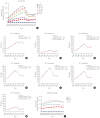Recent Changes in the Incidence of Thyroid Cancer in Korea between 2005 and 2018: Analysis of Korean National Data
- PMID: 36220137
- PMCID: PMC9633217
- DOI: 10.3803/EnM.2022.1533
Recent Changes in the Incidence of Thyroid Cancer in Korea between 2005 and 2018: Analysis of Korean National Data
Abstract
Backgruound: In this study, we evaluated the recent changes in the standardized, age-specific, stage-specific incidence rates (IRs) of thyroid cancer in Korea and compared them with the incidence data reported by the Surveillance, Epidemiology, and End Results Program.
Methods: The analysis was conducted using the incidence data (2005 to 2018) from the Statistics Korea and Korea Central Cancer Registry.
Results: The age-standardized IR (SIR) of thyroid cancer increased from 24.09 per 100,000 in 2005 to 74.83 in 2012 (annual percent change [APC], 14.5). From 2012 to 2015, the SIR decreased to 42.52 (APC, -17.9) and then remained stable until 2018 (APC, 2.1). This trend was similar in both men and women. Regarding age-specific IRs, the IRs for ages of 30 years and older showed a trend similar to that of the SIR; however, for ages below 30 years, no significant reduction was observed from the vertex of IR in 2015. Regarding stage-specific IRs, the increase was more prominent in those with regional disease (APC, 17.4) than in those with localized disease until 2012; then, the IR decreased until 2015 (APC, -16.1). The average APC from 2005 to 2018 increased in men, those under the age of 30 years, and those with regional disease.
Conclusion: The SIR in Korea peaked in 2012 and decreased until 2015 and then remained stable until 2018. However, in young individuals under the age of 30 years, the IR did not significantly decrease but tended to increase again. In terms of stage-specific IRs, the sharpest increase was seen among those with regional disease.
Keywords: Epidemiology; Incidence; Korea; Thyroid neoplasms.
Conflict of interest statement
No potential conflict of interest relevant to this article was reported.
Figures



Similar articles
-
Long-Term Changes in the Mortality Rates of Thyroid Cancer in Korea: Analysis of Korean National Data from 1985 to 2020.Endocrinol Metab (Seoul). 2023 Oct;38(5):588-595. doi: 10.3803/EnM.2023.1723. Epub 2023 Sep 8. Endocrinol Metab (Seoul). 2023. PMID: 37679950 Free PMC article.
-
Thyroid Cancer Incidence Among Korean Individuals: A Comparison of South Korea and the United States.Laryngoscope. 2024 Sep;134(9):4156-4160. doi: 10.1002/lary.31490. Epub 2024 May 10. Laryngoscope. 2024. PMID: 38727257
-
Changes in standardized mortality rates from thyroid cancer in Korea between 1985 and 2015: Analysis of Korean national data.Cancer. 2017 Dec 15;123(24):4808-4814. doi: 10.1002/cncr.30943. Epub 2017 Aug 17. Cancer. 2017. PMID: 28817188
-
Italian cancer figures, report 2012: Cancer in children and adolescents.Epidemiol Prev. 2013 Jan-Feb;37(1 Suppl 1):1-225. Epidemiol Prev. 2013. PMID: 23585445 English, Italian.
-
Thyroid cancer is the most common cancer in women, based on the data from population-based cancer registries, South Korea.Jpn J Clin Oncol. 2013 Oct;43(10):1039-46. doi: 10.1093/jjco/hyt102. Epub 2013 Jul 25. Jpn J Clin Oncol. 2013. PMID: 23894204
Cited by
-
Trends in Thyroid Cancer Mortality Rates in Korea: Insights from National Health Database.Endocrinol Metab (Seoul). 2024 Dec;39(6):853-855. doi: 10.3803/EnM.2024.2251. Epub 2024 Dec 11. Endocrinol Metab (Seoul). 2024. PMID: 39658781 Free PMC article. No abstract available.
-
Bilateral axillo-breast approach robotic total thyroidectomy without isthmectomy: a case report.Ewha Med J. 2024 Jan;47(1):e7. doi: 10.12771/emj.2024.e7. Epub 2024 Jan 31. Ewha Med J. 2024. PMID: 40703399 Free PMC article.
-
Age and Post-Lobectomy Recurrence after Endoscopic or Robotic Thyroid Surgery: A Retrospective Cohort Study of 2348 Papillary Thyroid Carcinoma Patients.Cancers (Basel). 2023 Nov 21;15(23):5506. doi: 10.3390/cancers15235506. Cancers (Basel). 2023. PMID: 38067209 Free PMC article.
-
Cost-Effectiveness of Active Surveillance Compared to Early Surgery of Small Papillary Thyroid Cancer: A Retrospective Study on a Korean Population.J Korean Med Sci. 2023 Aug 28;38(34):e264. doi: 10.3346/jkms.2023.38.e264. J Korean Med Sci. 2023. PMID: 37644680 Free PMC article.
-
Cost-Utility Analysis of Early Detection with Ultrasonography of Differentiated Thyroid Cancer: A Retrospective Study on a Korean Population.Endocrinol Metab (Seoul). 2024 Apr;39(2):310-323. doi: 10.3803/EnM.2023.1870. Epub 2024 Apr 9. Endocrinol Metab (Seoul). 2024. PMID: 38590123 Free PMC article.
References
-
- Li M, Dal Maso L, Vaccarella S. Global trends in thyroid cancer incidence and the impact of overdiagnosis. Lancet Diabetes Endocrinol. 2020;8:468–70. - PubMed
-
- Kim J, Gosnell JE, Roman SA. Geographic influences in the global rise of thyroid cancer. Nat Rev Endocrinol. 2020;16:17–29. - PubMed
-
- Miranda-Filho A, Lortet-Tieulent J, Bray F, Cao B, Franceschi S, Vaccarella S, et al. Thyroid cancer incidence trends by histology in 25 countries: a population-based study. Lancet Diabetes Endocrinol. 2021;9:225–34. - PubMed
Publication types
MeSH terms
LinkOut - more resources
Full Text Sources
Medical

